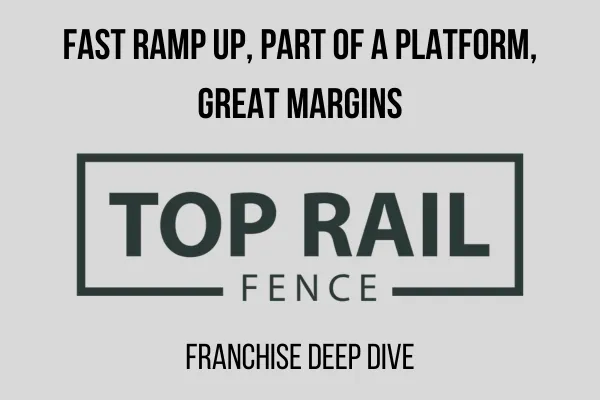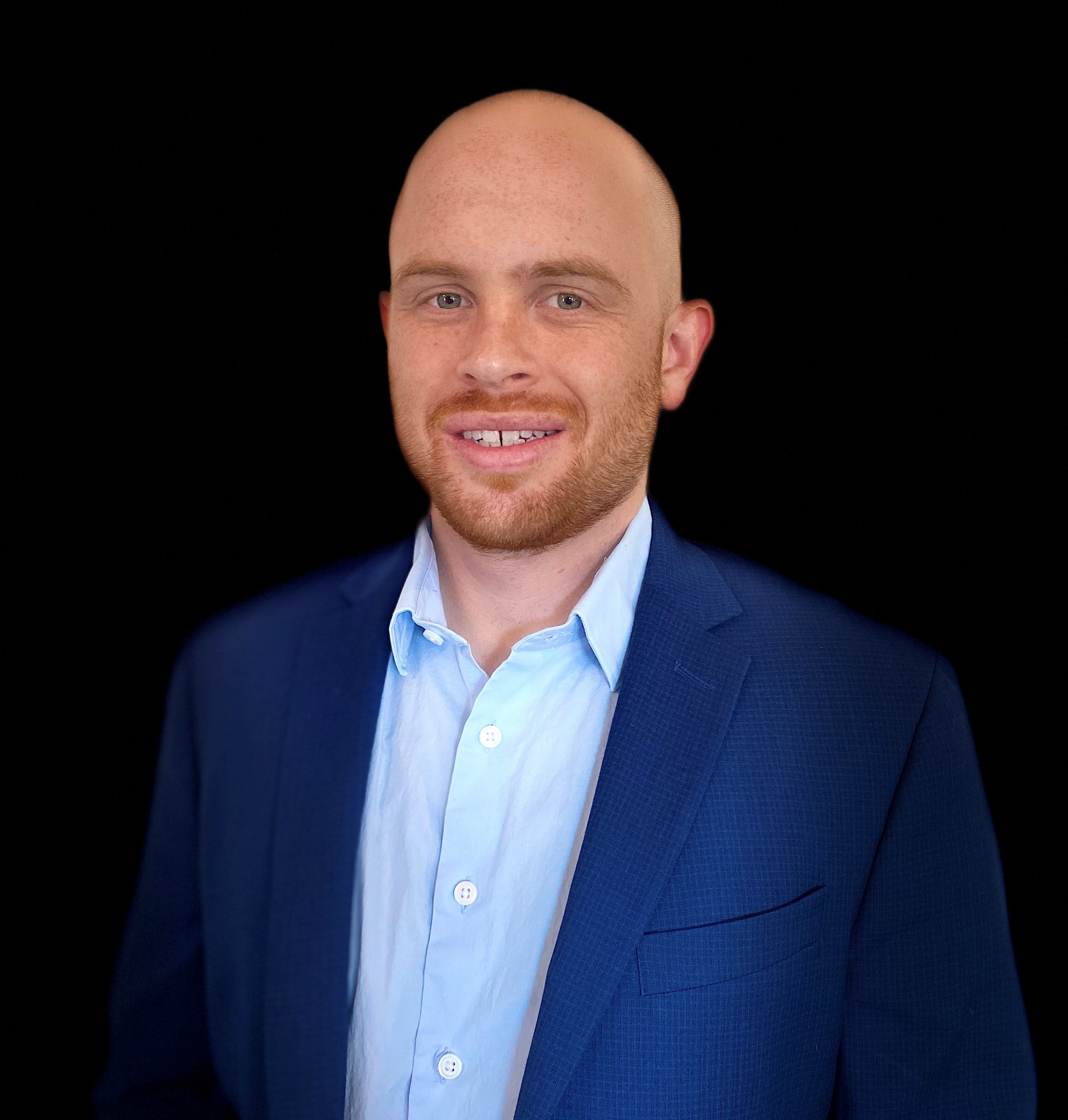
A Fast Growing Fencing Franchise with Owners Already Doing Millions in Revenue
Inside the Top Rail Fence Franchise: Smart Model or Too Early to Tell?
Most people looking at franchises fall into two traps: either they buy into marketing hype or they overcorrect and dismiss anything new.
Top Rail Fence sits right in the middle of that tension.
It's part of the fast-growing Homefront Brands platform. It launched as a franchise in 2023. That alone would usually be a red flag for me — two-and-a-half years is not much of a track record. But the franchise is part of a large platform with strong infrastructure, the leadership team isn’t new to franchising, and there are over 100 open territories (some franchisees own multiple territories). More importantly, the early numbers from their first 68 franchisees are strong, and the operational model is unusually clean.
In my interview with Mike Aiello, the Director of Franchise Development, we walked through the entire system: how it works, what makes it different, and who it’s built for. What follows is a detailed summary and my analysis for those considering investing in this brand — or anything like it.
If you want to listen to the full interview you can enjoy it on:
What Is Top Rail Fence?
Top Rail is a fencing installation franchise serving residential and commercial customers. Franchisees don’t do the installs themselves — they manage subcontractor crews, coordinate scheduling, and oversee quality. The franchisor provides centralized lead generation, in-house call center support, and a tech stack that includes quoting, CRM, and materials planning tools.
The model came out of a successful South Carolina fence company that started in 2015 and partnered with Homefront Brands to scale through franchising. That partnership led to a formal launch in February 2023.
Unlike many emerging brands that start franchising too early, Top Rail built a large infrastructure of support before granting franchise licesnes. The platform backing it — Homefront Brands — has serious infrastructure and experienced leadership, including Jeff Duden (ex-AdvantaClean) and Todd Bingham (Brand President), both with national franchise growth track records.
So yes, the franchise is new. But the playbook is built by people who’ve done this before — and that’s reflected in the systems.
The Operating Model: What You’re Really Signing Up For
If you become a Top Rail franchisee, here’s what you’ll actually be doing every day:
1. You’re managing subcontractors — not employees.
Every fence is installed by 1099 crews, not W-2 labor. That’s a big advantage in a labor-constrained market. It also means your job is quality control, scheduling, customer communication, and managing vendor relationships.
Finding subcontractors isn’t positioned as a major challenge — most franchisees line up at least one crew during the onboarding period and build from there. The team encourages a test-and-trust approach: feed work to a few crews, evaluate quality and responsiveness, and build loyalty over time.
2. You’re doing sales — or you’re hiring someone who is.
Most early owners wear the sales hat. You go to the home, walk the property, talk through needs, generate a proposal, and close the deal — often on the spot. The tech makes quoting straightforward, and the company offers 35+ hours of sales training including live scenarios inside a house built inside their warehouse in Charlotte.
If you’re not comfortable selling, you’ll need to hire a salesperson — ideally before launch. Top Rail encourages bringing that person to training with you. It’s not passive ownership, especially in the first year. If you hire salesperson, you will be doing the operations of the business but most owners do the sale and hire a project manager.
3. You’re managing a warehouse.
Top Rail requires every franchisee to secure a 1,000+ sq ft warehouse within 90 days. They are looking for a small indoor/outdoor space where you store fence panels, tools, and hardware. Why? Because bulk ordering from their vendor partners dramatically lowers material costs and gives you more control over install scheduling.
This is one of the key levers in the business model. Owners who run lean, organized warehouses tend to hit better margins.
Lead Generation and Marketing
This is where the platform shows its strength. Most emerging brands throw you a playbook and say “go figure it out.” Top Rail gives you a team.
Lead generation runs through five channels, most of which are managed or supported directly by the franchisor:
Paid Media
Facebook/Instagram ads, Google PPC, and LSA (Local Services Ads). Franchisees choose from vetted marketing agencies, but 90% use the same top performer. You meet weekly with a marketing coach to review lead cost, close rate, ticket size, and reallocate spend.Local SEO & Social Media
You’re given a local website and social channels. Their team can post seasonal promotions and branded content, but they rely on you to send before-and-after photos and job site shots. They emphasize that raw, real content (old fence vs. new fence) outperforms polished marketing.Automated Campaigns
Once a fence is installed, customers get automated follow-ups — like a “time to stain” message six months later. They also run win-back campaigns for quotes that were never opened or followed up on. That infrastructure matters, especially in a high-ticket, low-frequency service like fencing.Referral Marketing
Franchisees are coached to build relationships with realtors, pool contractors, HOA presidents — anyone whose clients might need a fence. Homefront gives examples, tools, and support, but you have to get out and do it.Local Events
Trade shows, dog shelters, farmer’s markets. One franchisee in Tampa partnered with a humane society and gave out dog collars with his brand name — and still drops off more every month. These events don’t always bring direct installs, but they build the brand in your zip code.
If you’re someone who understands the compounding nature of local marketing — or is willing to learn — this system gives you the tools and support to do it well.
Tech Stack
Three main tools:
ServiceMinder: CRM (lead tracking, contact data, campaign logic)
FenceCloud: Quote builder used on-site with customers
Site Planner: Translates quote into material list for purchasing
All three are fully integrated and pre-loaded. You're trained on all of them before you launch, and support is available post-launch.
Economics
This part should be approached carefully — not because the numbers are bad, but because they’re early.
According to the 2025 FDD:
Top third average revenue: $2.2M
Middle third: $921K
Bottom third: $496K
These are full 12-month numbers from franchisees who have been open, on average, 14–22 months. That’s a very short time horizon. But it’s also meaningful: most franchises don't disclose this level of detail until year 4 or 5. And many don’t show revenue above $1M even after five years.
Gross margins for the top third are averaging 42.8% — above the 40% target. Labor is expected to be around 20%, materials around 40%, with overhead and marketing making up the rest. That leaves room for a healthy net margin if you run tight.
What makes this more believable is that the founder — who still runs his original location — is now being outpaced by several franchisees. That’s a good sign in an emerging brand.
Who Is This A Good Fit For?
Let’s be blunt: this is not for someone looking to “buy themselves a paycheck” and fade into the background. Top Rail is built for people who want to build a real business — and aren’t afraid to be in the driver’s seat.
You’re a good fit if you:
Want to operate or oversee a team day-to-day
Have experience in sales, ops, logistics, or project management
Understand the benefits of a platform brand (or want to expand later into other verticals)
Are willing to put in the work early and build strong subcontractor, vendor, and local partner relationships
See value in warehouse operations and physical service models
You’re probably not a fit if:
You’re looking for passive income or absentee ownership
You don’t want to be involved in sales or hire a salesperson
You’re uncomfortable managing vendors or trades
You’re not open to following systems and being held accountable
This business doesn’t require specific industry experience — but it does require buy-in. Owners who follow the system, hire early, and run it like a business (not a gig) are the ones who scale quickly.
The Platform Play
One of the more compelling angles is how Top Rail fits within the larger Homefront Brands portfolio. Several franchisees own more than one brand — often stacking them within the same territory to leverage brand recognition and shared customer lists.
Example: A Window Hero owner (window cleaning and pressure washing) adds Top Rail in the same market. He already has customer trust, a local base, and marketing infrastructure. That’s real synergy.
If you're the kind of operator who plans to scale beyond one unit or brand, being part of a platform like this gives you options. There’s a path here to build a multi-brand, multi-million-dollar portfolio within the same zip codes — not across five states.
Final Thoughts
Top Rail Fence isn’t perfect. It’s early. It’s active. It requires effort. But what it offers is rare among young franchise systems:
Proven economics, not just projections
Real systems and support, not just promises
A clear playbook and a leadership team with franchise scaling experience
If you’re early in your franchise research and just want something “safe,” this probably isn’t it. But if you’re someone who wants to get in early on a platform-backed brand, run a serious business, and build local market share while others are still figuring out their quoting software — Top Rail is worth a close look.
I’m watching this one closely. And I’m already seeing strong operators succeed in it.
If you’re curious about availability in your market or want help validating whether it’s the right fit, reach out to me directly. No pressure. Just real talk.
Let’s figure out what the right move is — even if it’s not this one.
